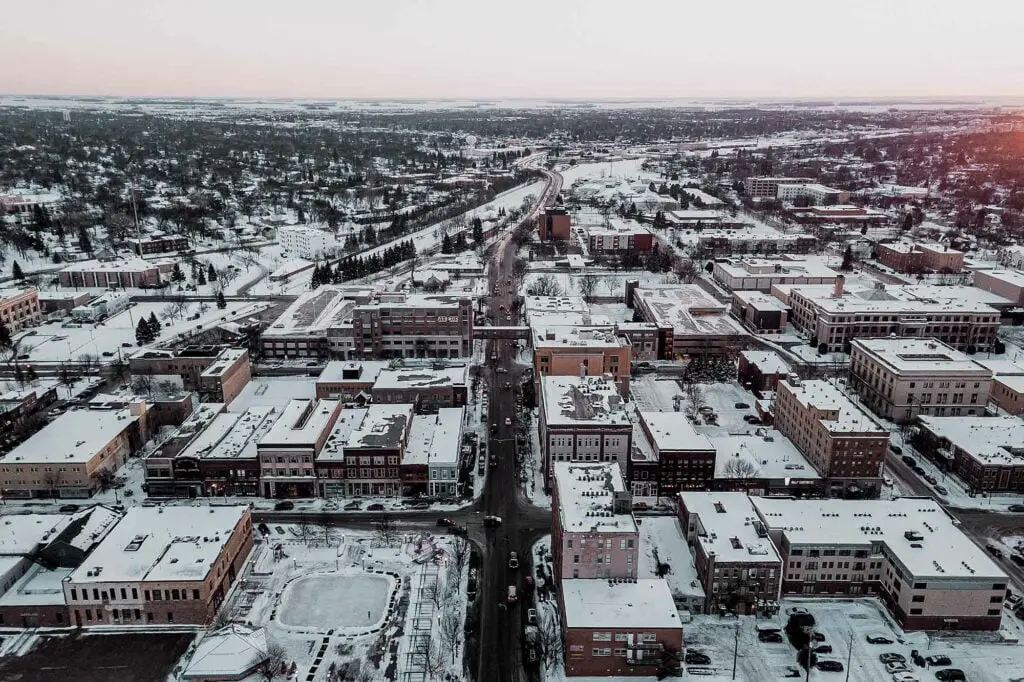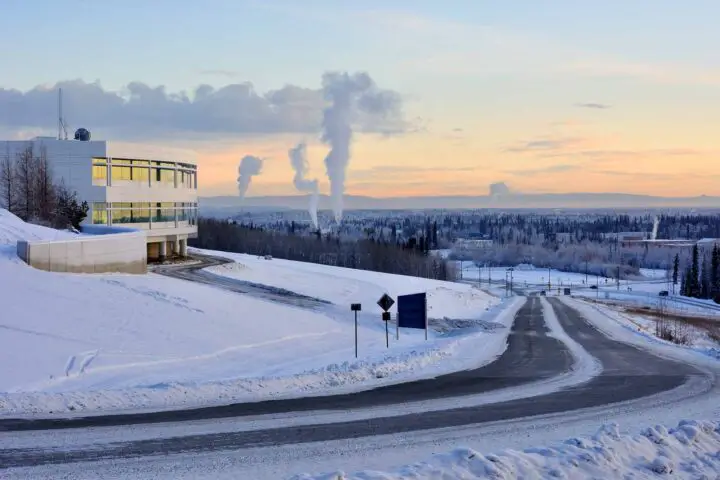Vous n'aimez pas trop la chaleur ? Vous ne pouvez pas attendre les premières chutes de neige ? Si vous aimez le temps froid aux États-Unis, il vous suffit, dans la plupart des cas, de vous déplacer vers le nord. Toutes les villes les plus froides des États-Unis, à l'exception d'une seule, se trouvent dans le Haut-Midwest, où les fréquents souffles arctiques rendent les hivers plus brutaux que dans le reste du pays, avec certaines des températures les plus froides en dehors de l'Alaska !
Ci-dessous, nous avons dressé la liste des 10 villes américaines les plus froides et nous expliquons un peu plus pourquoi le Haut-Midwest peut être tellement plus froid que le reste du pays. Pour établir notre classement, nous avons utilisé des données climatiques en nous basant sur la température basse moyenne du mois le plus froid dans chaque ville.
Quelles sont les 10 villes américaines les plus froides ?
Si nous incluions toutes les petites villes dans cette liste, elle serait dominée par les communautés arctiques de l'Alaska, dont les températures extrêmes en hiver sont bien connues. Cependant, pour notre liste, nous considérerons comme une ville tout endroit comptant plus de 10 000 habitants.
- Fairbanks, Alaska : -16.9° F température basse moyenne du mois le plus froid
- Grand Forks, Dakota du Nord : -3.1° F
- Williston, Dakota du Nord : 0.1° F
- Fargo, Dakota du Nord : 0.1° F
- Duluth, Minnesota : 1.5° F
- Aberdeen, Dakota du Sud : 1.5° F
- St. Cloud, Minnesota : 1.8° F
- Bismarck, Dakota du Nord : 2.2° F
- Marquette, Michigan : 5.2° F
- Huron, Dakota du Sud : 6.6° F
Fairbanks est la plus grande ville d'Alaska.Il n'est donc pas surprenant qu'elle soit en tête de notre liste, et de loin. Mais les trois villes américaines les plus froides suivantes se trouvent toutes dans le Dakota du Nord, un État connu pour son froid en plein hiver.
Pourquoi le Dakota du Nord est si froid

Ce n'est pas pour rien que le Dakota du Nord compte parmi les villes les plus froides des États-Unis. Grâce à sa latitude septentrionale, l'État connaît des températures froides tout au long de l'année. Les températures basses moyennes tombent à près de zéro ou en dessous pendant la nuit durant les mois d'hiver, et les températures peuvent rester sous le point de congélation pendant plusieurs jours. Les température la plus froide jamais enregistré dans l'État est un froid glacial de -60F.
Les masses d'air froid de l'Arctique peuvent rapidement envahir la région, rendant les dépressions inférieures à zéro fréquentes en hiver. De grands systèmes anticycloniques sur le nord Canada comprimez l'air froid et poussez-le vers le sud, avec moins de chances de se modérer avant qu'il n'atteigne le haut Midwest.
Le Dakota du Nord et l'Alaska ne sont pas les seuls à être froids : Le Dakota du Sud, le nord du Minnesota, le nord du Wisconsin et même la péninsule supérieure du Michigan connaissent des hivers tout aussi froids. Le Montana détient également le record de la température la plus froide enregistrée dans le Lower 48 : -70F !
Le Dakota du Nord a aussi très chaud
Aussi froid que soit l'État en hiver, il peut devenir brutalement chaud en été. Certaines des températures les plus chaudes du pays ont été enregistrées ici : le record de l'État est de 120°F, établi en 1936. Les températures moyennes en journée atteignent les 90°F dans le Dakota en juillet et août, les périodes les plus chaudes de l'année.
Le froid de l'Alaska vient directement de l'Arctique

L'Alaska est l'État le plus froid du pays, et son climat est encore plus glacial que celui de la majeure partie du Canada. Pour être clair, toutes les régions de l'Alaska ne sont pas aussi froides, et cela varie d'un endroit à l'autre en fonction de la distance qui vous sépare du sud, de la provenance du vent et d'autres facteurs. Mais les villes les plus froides de l'Alaska ont tendance à avoir plus en commun avec le nord du Canada qu'avec la plupart des États-Unis.
Cela est dû à la proximité de l'État avec le cercle arctique. Il fait suffisamment froid en Alaska pour que le pergélisol existe, et l'air froid de l'Arctique balaie fréquemment le sud, même pendant les mois les plus chauds. Une journée d'été chaude en Alaska serait considérée comme une journée d'été moyenne dans la plupart des 48 États américains inférieurs.
Vous préférez un temps plus chaud ? Nous vous invitons à consulter notre liste des sites suivants villes les plus chaudes des États-Unis à la place. Ou peut-être préférez-vous le froid et la neige ? Nous avons également une liste des sites suivants villes les plus enneigéesaussi. Vous avez une idée pour une future liste ? Faites-nous en part dans les commentaires.
Découvrez le monde fascinant de la météo avec la deuxième édition de Weather Watch : une introduction à l'Amérique Le temps et le climat. Ce livre ne se contente pas d'expliquer les concepts météorologiques et climatiques : il leur donne vie.
Veille météorologique est parfait pour les adolescents et les adultes qui souhaitent approfondir leur compréhension du monde dynamique de la météorologie. Simplifiant le complexe, ce livre décompose la science de la météo en concepts plus petits et faciles à digérer, vous permettant d'approfondir vos connaissances à chaque chapitre.
Voici à quoi s'attendre :
- Des informations détaillées sur nuages, pression et vent, lecture de cartes météorologiques, ouragans et tempêtes tropicales
- Discussion éclairante sur le changement climatique
- Conseils essentiels pour l’achat d’une station météo
- Informations critiques sur les conditions météorologiques extrêmes et tornades
- Apprendre à prévoir la météo soi-même
Cette deuxième édition est entièrement reformatée avec plus de 30 pages de nouveau contenu, notamment une analyse avancée des cartes météorologiques et la météo spatiale. C'est plus attrayant visuellement avec des illustrations et des graphiques supplémentaires. Chaque chapitre se termine désormais par des liens pratiques pour un apprentissage plus approfondi, et disséminés tout au long du livre, des événements météorologiques américains captivants servent d'illustrations réelles des concepts introduits.





